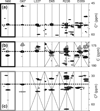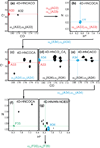Practical aspects of NMR signal assignment in larger and challenging proteins
- PMID: 24534088
- PMCID: PMC3951217
- DOI: 10.1016/j.pnmrs.2013.12.001
Practical aspects of NMR signal assignment in larger and challenging proteins
Abstract
NMR has matured into a technique routinely employed for studying proteins in near physiological conditions. However, applications to larger proteins are impeded by the complexity of the various correlation maps necessary to assign NMR signals. This article reviews the data analysis techniques traditionally employed for resonance assignment and describes alternative protocols necessary for overcoming challenges in large protein spectra. In particular, simultaneous analysis of multiple spectra may help overcome ambiguities or may reveal correlations in an indirect manner. Similarly, visualization of orthogonal planes in a multidimensional spectrum can provide alternative assignment procedures. We describe examples of such strategies for assignment of backbone, methyl, and nOe resonances. We describe experimental aspects of data acquisition for the related experiments and provide guidelines for preliminary studies. Focus is placed on large folded monomeric proteins and examples are provided for 37, 48, 53, and 81 kDa proteins.
Keywords: Large protein; Nuclear Magnetic Resonance (NMR); Resonance assignment; Spectra analysis; Spectral overlap.
Copyright © 2013 Elsevier B.V. All rights reserved.
Figures














Similar articles
-
Covariance NMR Processing and Analysis for Protein Assignment.Methods Mol Biol. 2018;1688:353-373. doi: 10.1007/978-1-4939-7386-6_16. Methods Mol Biol. 2018. PMID: 29151217
-
Resonance assignment strategies for the analysis of NMR spectra of proteins.Mol Biotechnol. 1994 Aug;2(1):61-93. doi: 10.1007/BF02789290. Mol Biotechnol. 1994. PMID: 7866869 Review.
-
A Hausdorff-based NOE assignment algorithm using protein backbone determined from residual dipolar couplings and rotamer patterns.Comput Syst Bioinformatics Conf. 2008;7:169-81. Comput Syst Bioinformatics Conf. 2008. PMID: 19642278
-
High-dimensional NMR spectra for structural studies of biomolecules.Chemphyschem. 2013 Sep 16;14(13):3015-25. doi: 10.1002/cphc.201300277. Epub 2013 Jun 21. Chemphyschem. 2013. PMID: 23794393 Review.
-
Triple-resonance NOESY-based experiments with improved spectral resolution: applications to structural characterization of unfolded, partially folded and folded proteins.J Biomol NMR. 1997 Feb;9(2):181-200. doi: 10.1023/a:1018658305040. J Biomol NMR. 1997. PMID: 9090132
Cited by
-
NMR Lineshape Analysis of Intrinsically Disordered Protein Interactions.Methods Mol Biol. 2020;2141:477-504. doi: 10.1007/978-1-0716-0524-0_24. Methods Mol Biol. 2020. PMID: 32696373 Free PMC article.
-
Distance-independent Cross-correlated Relaxation and Isotropic Chemical Shift Modulation in Protein Dynamics Studies.Chemphyschem. 2019 Jan 21;20(2):178-196. doi: 10.1002/cphc.201800602. Epub 2018 Sep 3. Chemphyschem. 2019. PMID: 30110510 Free PMC article. Review.
-
The LC8-RavP ensemble Structure Evinces A Role for LC8 in Regulating Lyssavirus Polymerase Functionality.J Mol Biol. 2019 Dec 6;431(24):4959-4977. doi: 10.1016/j.jmb.2019.10.011. Epub 2019 Oct 18. J Mol Biol. 2019. PMID: 31634467 Free PMC article.
-
The MLL1 trimeric catalytic complex is a dynamic conformational ensemble stabilized by multiple weak interactions.Nucleic Acids Res. 2019 Sep 26;47(17):9433-9447. doi: 10.1093/nar/gkz697. Nucleic Acids Res. 2019. PMID: 31400120 Free PMC article.
-
Covariance nuclear magnetic resonance methods for obtaining protein assignments and novel correlations.Concepts Magn Reson Part A Bridg Educ Res. 2017 Mar;46A(2):e21437. doi: 10.1002/cmr.a.21437. Epub 2018 Sep 16. Concepts Magn Reson Part A Bridg Educ Res. 2017. PMID: 30288152 Free PMC article.
References
-
- Keller RLJ. The Computer Aided Resonance Assignment Tutorial, Cantina Verlag, Goldau. 2004
-
- Vranken WF, Boucher W, Stevens TJ, Fogh RH, Pajon A, Llinas M, Ulrich EL, Markley JL, Ionides J, Laue ED. The CCPN data model for NMR spectroscopy: development of a software pipeline. Proteins: Struct. Funct. Bioinform. 2005;59:687–696. - PubMed
-
- Goddard T, Kneller D. SPARKY 3. San Fransisco: Univeristy of California;
-
- Johnson BA, Blevins RA. NMR view: a computer program for the visualization and analysis of NMR data. J. Biomol. NMR. 1994;4:603–614. - PubMed
-
- Peti W, Page R. Strategies to maximize heterologous protein expression in Escherichia coli with minimal cost. Protein Exp. Purif. 2007;51:1–10. - PubMed
Publication types
MeSH terms
Substances
Grants and funding
LinkOut - more resources
Full Text Sources
Other Literature Sources

